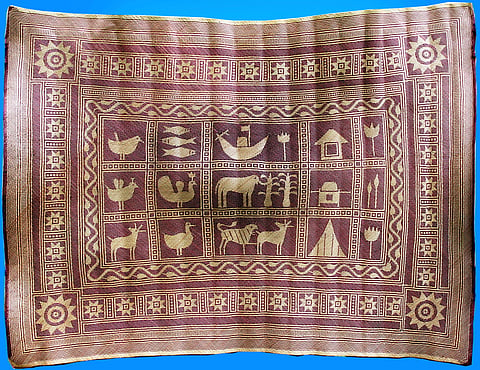
- Destinations
- Experiences
- Stay
- What's new
- Celebrating People
- Responsible Tourism
- CampaignsCampaigns
- SubscribeSubscribe
- Buy Now

When I was a kid and an air-conditioner in a middle-income home was but a dream, I recall my grandmother rolling out a "shital pati" during summer and urging us, her grandchildren, to sleep on it. Now, several decades later, I cannot say for sure if it was the "cool mat" or her power of storytelling that put us to sleep during those hot summer nights. But the smooth and silky feel of the mat remains etched in my memory.
Recently, the shital pati re-entered my life, but in a somewhat different avatar—that of a beautiful overnight bag. Not only this, West Bengal is home to several eco-friendly crafts. Here's a look at some of them.
A traditional craft from Cooch Behar in West Bengal, the shital pati is woven from the muthra reed (Marantha dichotoma). The green cane is soaked in water and then sliced into thin strips and the pati is made by weaving these in an interlacing pattern. The quality of the mat is determined by the fine texture of the pati and the smoothness of the weave. But like many other traditional crafts, the shital pati too would also have faded away, had it not been for the craftspeople themselves. Apart from making the regular mats, they've now branched into crafting all sorts of bags with these mats—purses, totes, office bags, overnighters etc.
West Bengal is also home to another variety of mats, called the madur. In earlier days, whenever guests came home, especially in rural Bengal, it was customary to immediately roll out a madur for them to sit on. Once a flourishing cottage industry in the former Midnapore district of West Bengal, only a handful pursue it today. The classic madur is woven from a local reed called madur kathi, usually found in marshy, swampy areas. Here the weave is different with cotton threads used as warp and madur kathi used as weft. This makes the mat more pliable and foldable. It was again the urge to survive that compelled the craftspeople to innovate and they now make table mats, table runners, curtains, wall hangings and letter holders with the humble madur.
My next stop at the crafts fair was another stall from Paschim Midnapore district. A young couple, oblivious to the crowd's attention, sat weaving. They were moulding a plethora of diverse things with strands of dried grass. I saw hair clips, bangles, boxes, trays and even plant holders, all crafted from those strands. It was quite remarkable to watch.
It was at the fair that I came across dhokras (not to be confused with the metallic dokra) for the first time. Basically, dhokra is the art of weaving jute-based fibres in a rudimentary loom, a speciality of the women of the Rajbanghsi community from the South Dinajpur district. Men here are not allowed to weave. Even among this community, the women have learned to devise various products from the woven textile to stay competitive—sling bags to totes to mobile holders, mats, throws etc.
With craftspeople from nearly 15 districts of West Bengal exhibiting at the fair, my bags were already overflowing with bric-a-brac. But it was too much of a temptation not to stop at the stall selling products made of buffalo horn. The shiny black objects, with a hint of brown here and there, ranged from decorative pieces to utility items, and had attracted quite a crowd. Some young students had polished off the horn-crafted hair accessories even before I could have a look at them. So I grabbed at the cutleries, especially the various designer spoons. Perfect surprise gifts for friends.
But there was one sad, pervasive note to the entire fair—the aggressive competition from factory-made products and Chinese artefacts. Handcrafting each item to perfection is a time-consuming job and the increased labour cost, in turn, raises the selling price. Moreover, the younger generation is not attracted to work in these dying arts and crafts and senior craftspeople fear their skills will die with them.
Sadly, while we talk about using eco-friendly products to rid Mother Earth of plastic, these rural crafts, which could have reduced the use of non-biodegradable products in our daily lives, languish in anonymity.
